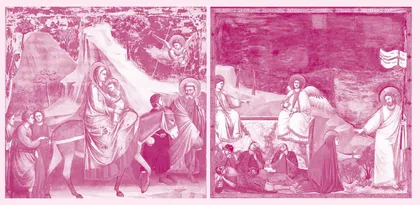The Shepherd Boy Painter (Ⅱ) 牧童画师(下)
作者: By V. M. Hillyer

——V. M. 希利尔(仲秋译)
But it is not for what he did himself that Cimabue is famous. He is known chiefly as the teacher of some one who became a much greater artist. Cimabue was walking one day in the country, not far from Florence, when he came upon a shepherd boy tending his flocks. The boy, while watching his sheep, was drawing pictures of them on a piece of slate with a sharp stone. Cimabue, looking over the boy’s shoulder, was amazed at the picture he saw and he asked the boy his name. “Giotto,” the boy replied, which was the short pet name for Ambrogiotto.
Cimabue asked Giotto if he wouldn'tlike to go to Florence and study drawingand painting. The boy was delighted tohave such a chance. So,gettingpermission from his father, he went to liveand study with Cimabue. When Giottogrew up, he painted many famous picturesof Christ, the Virgin Mary, and especially ofSaint Francis, whom Cimabue had painted.
不过契马部埃这么有名,却不是源于他的绘画成就,而主要是因为他的一个学生,这个学生后来成了一个伟大的画家。据说,契马部埃有一天在离佛罗伦萨不远的乡间漫步,无意间看到一个牧童,这个牧童一边放羊,一边用一块尖尖的石头在一块石板上画羊。契马部埃上前去看了看,对男孩的绘画感到很惊讶,于是问牧童的名字。男孩回答说:“乔托。”乔托是安布罗乔托的简称。
契马部埃问乔托愿不愿跟他回佛罗伦萨学习绘画。有这样一个机会,男孩自然非常开心。于是在征得了爸爸的同意之后,乔托就跟着契马部埃一起学习和生活。乔托长大后,他画了许多有关耶稣和圣母玛利亚的名画,最多的当然还是契马部埃最常画的圣方济。
Saint Francis lived in a town near Florence called Assisi. In Assisi there is a church built in his honor. In fact, there are two churches, one on top of the other. In the upper church, Giotto painted along the walls a series of pictures that told stories from the life of Saint Francis. Among many wonderful things Saint Francis used to do was to preach sermons to the birds that gathered round him to listen. The picture below shows him doing this.
圣方济曾经住在阿西西小镇,距离佛罗伦萨不是很远。这个小镇有一座以圣方济的名字命名的教堂。事实上,教堂由上下两座小礼拜堂组合而成。在上面那座礼拜堂的墙上,乔托画了许多关于圣方济的画作,描述的是圣方济的生平故事。在关于圣方济的许多传说当中,有一个故事说的是圣方济经常吸引鸟儿聚在他身旁,听他布道。下面这幅画描述的就是这一场景。
In those days, the paint used was not like that we have now. The paint we use is usually made by mixing colored powder with oil (we call it oil paint), and artists paint pictures on canvas. But in those days, oil was not used in making paint, and the painting was not done on canvas. Artists mixed their powdered colors with water and painted on the fresh plastered walls. Or they mixed their colors with something sticky, like egg or glue, and painted on dry plaster, wood, or copper. The first kind of painting on fresh plaster was called fresco, which means fresh. The second kind of painting was called tempera, which means mixed.
在契马部埃和乔托的那个时代,画家用的颜料和我们今天用的很不相同。我们今天用的颜料一般是由彩色粉和油混合而成的(我们称之为油彩),而今天的画家是在画布上作画。但是在契马部埃他们那个时代,画家不用油彩,也不把画画在画布上,而是将彩色粉和水混在一起,然后在刚刷好的石灰墙上作画。除此之外,当时的画家还有另一种作画方法:将彩色粉与一些比如蛋清、胶水这样的黏性物质混合,然后在干燥的石灰墙、木板或者铜板上作画。前一种画作被称作“湿壁画”,意思是画在潮湿的墙壁上的画;后一种画被称作“蛋彩画”,意思是用各种材料与蛋清混合而成的颜料画出的画。
The story is told that the Pope wished to have a picture painted and sent a messenger to Giotto to ask for a sample of the artist’s work. Giotto dipped his brush in some paint and, with a single swinging stroke, painted a perfect circle on a piece of wood and sent this to the Pope to show how skilled he was. Do you think you could draw a perfect circle without a compass with one stroke of a pencil? Try it. Then try doing it with a brush.
据说,有一次教皇想要找人画一幅画,就派使者去乔托那里,请他先画一个样本。乔托用画笔蘸了一点颜料,轻轻一挥就在木板上画出了一个非常规则的圆。他让使者直接把这个圆作为样本带给教皇看,以显示自己的绘画才能。想想看如果不借助圆规,你能一笔就画出一个规则的圆吗?你可以先用铅笔试着画—下,然后再用画笔尝试。
But even if you can do this, it does not mean you are a great artist. It is easy to trace a drawing. It is not much harder to copy a drawing without tracing. Thousands of people can paint a basket of fruit, a vase of flowers, a view of the sea or the land. That is just a copy. Thousands can copy the painting of a great artist so well that you can hardly tell the copy from the original. But very few people are able to invent a picture out of their own heads and put the parts together to make a beautiful painting. That is what takes genius!
不过,即使你能做到一笔画,圆也不意味着你就是一位伟大的画家。描摹一幅画是非常容易的,或看着临摹也不难。看着一篮子水果、一束花或一处漂亮的风景,有成千上万的人能将其画出,也有成千上万的人可以临摹出伟大画家的作品,甚至仿作得让人难辨真假。但是,却很少有人能够全凭自己创作出一幅作品,将各种零散的琐碎整合成一幅赏心悦目的图画,拥有这种创作能力的人,才能称得上是天才画家。